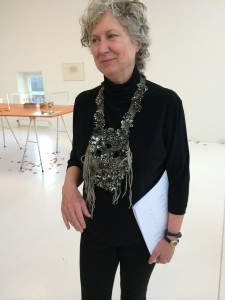This recap of the 2014 Art Jewelry Forum trip appeared in the Association for the Study of Jewelry and Related Arts newsletter.
Estonia? Where is that? Why are we going to Estonia? That was my reaction and I have no doubt it was the same for many of my Art Jewelry Forum colleagues when it was announced that this year’s trip was to Estonia and Sweden.

Once again, the Art Jewelry Forum trip was exciting and informative, no matter what aspect of jewelry ignites your passion. In September, we visited studios, galleries, schools, museums and private homes. We talked with gallerists, makers, professors and curators. AJF’s tireless volunteers put together a supremely organized trip that opened doors to venues we could not enter individually.
We met up in the picturesque Tallinn, Estonia, whose medieval Old town is a UNESCO World Heritage site. Kadri Mälk, one of the driving forces of Estonia’s art jewelry movement and head of the Metals Department at the Estonian Academy of Arts, was one of our “guides” with Tanel Veenre, a well-known maker whose work is represented by Ornamentum in Hudson, New York.
In Estonia, we met with students and viewed their work at the Academy, and then toured an exhibition called Ferromenaalne, featuring Estonian makers and metal smiths. The installation was as interesting as the work. We visited the studios of several emerging and established makers. Kadri invited us to her charming home on the top floor of an Old Town building.
It’s not every day that a U.S. “delegation” comes to Estonia – which was annexed by the Soviet Union in 1940 and became a free state again in 1991 — and we were treated as dignitaries. Our invitations included a reception with members of the Tallinn jewelry community at the home of the U.S. Ambassador, which was a treat. Indeed, word had gotten around. When I mentioned to one shopkeeper that I was part of the group, she said that she had heard about our visit.
Because of its location on the Baltic, so close the “outside” world, Estonia/Tallinn always had a different esprit than other areas formerly under Soviet domination. It was known as the “inner abroad” in Soviet times — the place where one went for a vacation or weekend respite without leaving the Soviet Union. The Scandinavian influence can be seen in jewelry and other crafts done when Estonia was part of the USSR. This was evident during our tour of the Estonian Museum of Applied Art and Design. Curator Ketli Tiitsar brought out jewelry from the archives, which showcased wealth not in precious gems but instead in intricate metalwork.
Our Estonian stay ended with the grand flourish of a delicious dinner at a trendy restaurant right on the Baltic where we watched a spectacular sunset. The next day, we flew to Stockholm.

Highly regarded gallerist Sofia Björkman, owner of Platina Gallery, was the boots-on-the-ground person who made our Swedish trip a delight. The gallery was celebrating its 15th year with a show we visited at a large exhibition space with a range of makers. The next day we were treated to a visit at an Architectural Digest-worthy apartment-home where some established makers showcased their work. From there we visited Gallery Sebastian Schildt’s shop with its flabbergastingly well-stocked metal shop, then went on to the intriguing Museum of Modern Art, followed by visits to makers’ studios.
We went to Konstfack University’s College of Art & Design to view student work and its enviable facilities. In the afternoon, along with other maker visits, we went to Platina Gallery itself. The day finished with a visit to maker Jenny Edlund’s home and studio where several makers who had traveled from Finland discussed and displayed their work.
We began our very full Saturday with what was supposed to be a three-hour train ride to Gotenberg, interrupted by a delay because of an accident on the track. Despite this, we were able to squeeze in almost every planned gallery and studio visit. We concluded by touring a landmark exhibit of Nordic jewelers – From the Coolest Corner — at the Röhsska Museum for Design, Fashion and Decorative Arts, and then flew back to the train station for our return trip.
Among the many makers we visited were Agnes Larsson, Hanna Hedman, Asa Elmstam, Marta Mattson, Helena Lehtinen, Eija Mustonen, Tarja Tupenen, Nelli Tanner, Karin Johansson, Maria Valdma, Piret Hirv, Kristiina Laurits, Eve Margus-Villems and Christer Jonsson.
We bid fond farewells the next morning, to start counting the days until next year’s trip to Barcelona.

